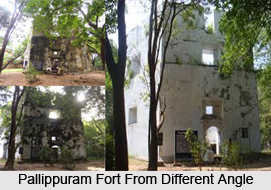 Pallipuram Fort is an island fort, which was built by the Portuguese in 1503. Pallipuram Fort is one of the famous and oldest remaining forts in Kerala. It is located in Ernakulam district and is popularly known as "Ayikkotta". It is the oldest existing European fort in India. In 1503 the Portuguese built the Pallipuram Fort. It is now a heritage site protected by the Kerala State Department of Archaeology. The fort boasts about magnificent European architectural style. Tourists from different places come to visit this historical edifice. The Pallipuram Fort is situated in the extreme northern part of the Vypeen Islands and heralds a glorious past within the territory of Kochi. Pallipuram Fort is one of the heritage sites of Kochi that deserves special mention among the tourist destinations in Kochi.
Pallipuram Fort is an island fort, which was built by the Portuguese in 1503. Pallipuram Fort is one of the famous and oldest remaining forts in Kerala. It is located in Ernakulam district and is popularly known as "Ayikkotta". It is the oldest existing European fort in India. In 1503 the Portuguese built the Pallipuram Fort. It is now a heritage site protected by the Kerala State Department of Archaeology. The fort boasts about magnificent European architectural style. Tourists from different places come to visit this historical edifice. The Pallipuram Fort is situated in the extreme northern part of the Vypeen Islands and heralds a glorious past within the territory of Kochi. Pallipuram Fort is one of the heritage sites of Kochi that deserves special mention among the tourist destinations in Kochi.
History of Pallipuram Fort
Pallipuram Fort located in the beautiful land of Kochi has a rich history. The fort has witnessed the rule of many mighty rulers and has been under the patronage of several Kingdoms. In the year 1661 the fort was captured by the Dutch invaders who had come to India in search of Indian spices. These spices were then quite popular in the Western countries. With the help of strategies and diplomacies Raja Kesava Dasan had purchased the fort from the Dutch. Raja Kesava Dasan was the ruler of the State of Travancore in the year 1789.
Etymology of Pallippuram Fort
Pallipuram got its name from the nearby Manjumatha Church, dedicated to the Lady of Snow where "Manju" in Malayalam denotes mist or snow, which was also built by the Portuguese roughly at the same time as the Fort. In Malayalam the word "Palli" means church and thus the surrounding areas of the church became Pallipuram. There is an interesting legend associated with the name of the church. Accordingly, when Tipu Sultan attacked Kochi and tried to destroy the church a miraculous mist came down, enveloped the church and hid it from him.
Architecture of Pallippuram Fort
The Pallippuram Fort is an exquisite example of its architectural beauty. The fort is of a hexagonal structure. The hexagonal structure of the fort was very fruitful for the inhabitants, as it enabled them to keep an eye on enemies or invader from the 6 walls of the monument. The height of the lower floor is raised to 5 feet from ground. The fort houses a cellar that was used for storing gunpowder. The gunpowder was used during invasions. The fort also has a wall which used to be a source of fresh water. Towards the northern direction of the Pallippuram Fort there is an opening which leads to the cellar. There is a circular slab stone, on which was installed a pillar on which the radiating wooden struts supporting the upper two floors must have rested. In ancient times the cellar was used to imprison the captured enemies. The local people believe that the cellar is a tunnel that leads to the Cheraman Masjid in Kodungallur. The walls of this beautiful fort are almost 6 feet thick, and the face of the fort measures a gigantic 32 feet in length and 34 feet in height. The fort is constructed using laterite, limestone, and wood. The walls are thickly plastered using mortar. The door way in the central circular slab is made of granite. All the six sides of the fort are overgrown with vegetation.
How to reach Pallippuram Fort
Pallippuram Fort is easily accessible by rail, road and air. It is well connected by an extended network of roadways. Cochin International Airport is the nearest airport, situated 40 km away from the fort. The nearest railway line, is the Ernakulam Railway Station situated 20kms from this fort. The tourists, in order to reach Pallipuram Fort, can avail of the ferry service operating from Ernakulam and Kochi to Vypeen.




